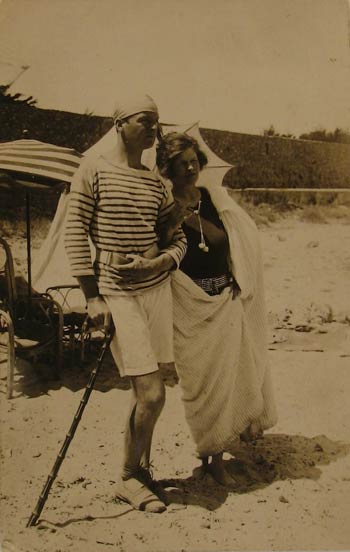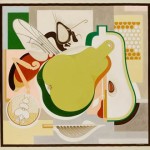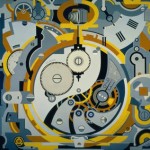By CHARLES GIULIANO
While this is the 50th anniversary of the 1967 “Summer of Love,” the fast ending season will also be noted for a media romance with the current exhibition “Making It New: The Art and Style of Sara and Gerald Murphy” at the Williams College Museum of Art where it remains on view through November 11. There has been a tidal wave of coverage with reviews from the New York Times and Newsweek to the New Yorker. Critics have been scrambling to weigh in on the fabulous and wonderfully gossipy story of the Lost Generation and its epicenter, the stylish and inventive American expatriates Gerald and Sara Murphy, and their circle of friends from Ernest Hemingway, Dorothy Parker, Cole Porter, Scott and Zelda Fitzgerald to the Parisians from Pablo Picasso to Fernand Leger and Diaghilev’s Ballet Russe de Monte Carlo.
The exhibition is filled with the memorabilia that surrounded them and the lifestyle that attracted such a brilliant and gifted entourage that followed them to the beach at Antibes. There Gerald raked the seaweed from the tiny stretch of sand, exercised vigorously, and mixed exotic cocktails before dinner at their Villa America. This became the title of a new play commissioned for the occasion and presented as a part of the season of the Williamstown Theatre Festival.
Oh yes, and when not carousing and swapping bon mots with their fabulous friends, before it all came tumbling down with the Great Depression which summarily brought to an end the Jazz Age and its flamboyant bohemians, Murphy found the time to produce about 14 highly meticulous paintings. The canvases represented a confluence between the synthetic cubism of French art and an uniquely American infusion of images gleaned from popular culture. Of these, seven surviving works are on view in the exhibition which took four years of intensive research for retiring Williams curator, Deborah Rothschild, to organize.
So far, the critics have focused on discovering the social and cultural influences of the Murphys, certainly the major thrust of the Williams installation, and have devoted less attention to a thorough critical analysis of the work itself, its remarkable aspects of innovation and synthesis, and its rightful position in the history of modernism. This ambivalence is exacerbated by the fact that when Murphy was forced to return to New York, and take over running the faltering family business, he abandoned any ambition to continue as a serious artist. The Murphys also endured the death of their two sons, one through a long illness, and the other quite suddenly. The paintings, those which survived, were rolled up and stored in an attic and never mentioned even to their neighbor, Calvin Tompkins, who wrote a famous New Yorker profile which was expanded into a short book “Living Well Is the Best Revenge.” Rothschild was inspired to undertake the Murphy project when she read a biography by Amanda Vaill, the best selling “Everybody Was So Young: A Lost Generation Love Story,” which was published in 1998.
When she read the inspiring Vaill biography Rothschild was on vacation having just mounted the exhibition “Young Hitler in Vienna.” That exhibition resulted in a strong attendance which for Williams College Art Museum publicist Suzanne Silich became the “gold standard” for the museum’s programming. “For us this has been a blockbuster summer,” Silich said. “Overall attendance is up 45% from last summer.” The featured exhibition last summer was “Jackson Pollock at Williams College a Tribute to Kirk Varnedoe Class of 1967.” The attendance for July this year has been 10,409 and has been even stronger during August. “There has been so much fantastic press for the exhibition” Silich said. “The Murphy exhibition has a myriad of entry points and is drawing on a cross section of visitors both younger and older. There has also been a synergy with the Williamstown Theatre Festival and our neighbors the Clark Art Institute. We see people visiting all the time still wearing their Clark buttons and the museum is also supportive in putting out our brochures so we see a lot of their visitors.”
While the Murphy show was launched with a Gala last July it is holding its “Un-Symposium” on Saturday, September 15 marking the beginning of the fall semester for the college. Silich explained that what is meant by an “Un-Symposium.” In the great style and flair of the Murphys the session from 1-5pm will include scholarly papers introduced by the curator, Deborah Rothschild, including biographer, Amanda Vaill, Harold Koda, curator of the Costume Institute of the Metropolitan Museum of Art, and art historian, Keneth E. Silver, of New York University. Between the papers will be interludes of period dance and music by Williams undergraduates, as well as, readings from Fitzgerald’s “Tender is the Night” which was based on the Murphys. The symposium will end with a demonstration, in the spirit of Gerald Murphy, by John Kinder on how to mix a perfect Martini. The sessions will appropriately end with cocktails.
- Gerald and Sara Murphy on La Garoupe beach, Antibes, Summer 1926 Photo © Estate of Honoria Murphy Donnelly/Licensed by VAGA, New York, NY
- Gerald Murphy, Wasp And Pear, oil on canvas, 1929. Art © Estate of Honoria Murphy Donnelly/Licensed by VAGA, New York, NY
- Gerald Murphy, Watch, oil on canvas, 1925. Art © Estate of Honoria Murphy Donnelly/Licensed by VAGA, New York, NY
Surely this is an occasion not to be missed. It is free and open to the general public but reservations are being taken on a first come basis. You may RSVP by calling Amy Tatro at 413 597 3055 or e mail at amy.m.tatro@williams.edu. The event, which will be held at the ’62 Center for Theatre and Dance, is sure to be the cat’s meow.
Williams College Museum of Art
"Making It New: The Art and Style of Sara and Gerald Murphy" is on view July 8 - November 11, 2007 at the Williams College Museum Of Art.
The exhibition will also be on view at the Yale University Art Gallery from February 26 - May 4, 2008.
All images are courtesy of the Williams College Museum Of Art.
Reproduction of images, including downloading, is prohibited without written authorization from VAGA, 350 Fifth Avenue, Suite 2820, New York, NY 10118. Tel: 212-736-6666; Fax: 212-736-6767; e-mail: info@vagarights.com







